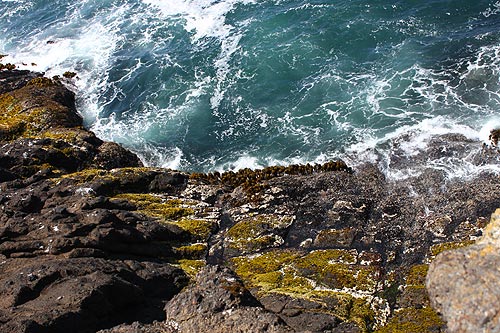Science Behind the Puffy, Bubbly Pillow Basalts of the Oregon Coast
Updated Periodically
By Oregon Coast Beach Connection staff

(Depoe Bay, Oregon) – Cruising around Depoe Bay and some other rocky stretches of coastline you may notice something different. Some spots are more jagged and pointed while others have a more rounded design. In Depoe Bay they’re more prominent, but you’ll see a few in selected spots around Yachats’ 804 Trail and just south of town.
Includes exclusive listings; some specials in winter
In Cannon Beach:
Includes rentals not listed anywhere else
In Manzanita, Wheeler, Rockaway Beach:
Some specials for winter
In Pacific City, Oceanside:
Some specials for winter
In Lincoln City:
Some specials for winter
In Depoe Bay, Gleneden Beach:
Some specials for winter
In Newport:
Look for some specials
In Waldport
Some specials for winter
In Yachats, Florence
Some specials for winter
You’re looking at what are called pillow basalts. No, these are not soft and fluffy, but rather the name comes from the puffy shape they acquire. The Oregon coast has them in many spots, but there are more concentrated in Depoe Bay than anywhere else.
A good example of how this happens is what was going on in Hawaii in 2019: massive lava flows hit the ocean and then erupted with a dramatic hiss and puff of smoke. What’s difficult to see behind the Rock 'n Roll show-like pyrotechnics is that they immediately cool into a rounded structure, called a lobe by geologists. The outer shell freezes into this shape.
According to Dr. Scott Burns, professor of geology at Portland State University, all this happened along the Oregon coast some 14 to 17 million years ago.
Back then, some of this action occurred on the sea floor (or what was then the sea floor, which was essentially all of Oregon’s coastline). When lava oozed up from the bottom, it too would freeze into these curvatures. But sometimes lava was still erupting and it would push its way up through the newly-formed lobe, cracking it, and then creating yet another lobe bud.
Later, as the eons progressed, Burns said, time and tide wore them down even further and smoothed them out.

One freaky fact: according to Burns these layers of basalt can be hundreds of meters thick. It’s quite possible these in the Depoe Bay area go down that far.
Burns is one of a few to have carbon-dated the pillow basalts of Depoe Bay, and it’s largely agreed upon those around this area are around 17 million to 14 million years old, which makes them part of the Columbia basalts. This was a time of incredible calamity in the ancient, proto-Oregon. Lava flows came from a massive hole in the Earth near what is now Idaho and seared across 300 miles or so until it reached the ocean.
These flows are responsible for just about every major landmark along the northern half of the coast, except for parts of Yachats and Cascade Head. In the Yachats, the bubble basalts and others of that kind are closer to 40 million years old or so.
So the big question remains: if Depoe Bay’s basalts but come from the same lava flow, why does it have pillow basalts and not the craggy, jagged displays of Tillamook Head or Neahkahnie Mountain?
“It has to do with being subaerial; that area of the land was above the water,” Burns said.
For whatever reason, a few miles of the land that now makes up Depoe Bay was above water, or in very shallow water. Those bubbly basalts run from about Fishing Rock State Recreation Area down to Rocky Creek State Scenic Viewpoint, roughly four miles on either side of Depoe Bay. South of Rocky Creek, along Otter Crest Loop Road, you’ll notice the rocks get more pointy and angular.
To see more of these, check out the Depoe Bay Virtual Tour, or the book, Ultimate Oregon Coast Travel: Depoe Bay.
Lodgings in Depoe Bay - Where to eat - Maps - Virtual Tours
Cannon Beach Lodging
Nehalem Bay Lodgings
Manzanita Hotels, Lodging
Three Capes Lodging
Pacific City Hotels, Lodging
Lincoln City Lodging
Depoe Bay Lodging
Newport Lodging
Waldport Lodging
Yachats Lodging
Oregon Coast Vacation Rentals
Oregon Coast Lodging Specials



More About Oregon Coast hotels, lodging.....
More About Oregon Coast Restaurants, Dining.....
LATEST Related Oregon Coast Articles
Weather good for most of Oregon. You'll need a camera to see. Astronomy
Ethereal in the East: Check Oregon, Washington Even Coastlines for Zodiacal L...
Look to east for 'False Dawn' - bring your camera. Sciences, astronomy
Sparks Above and Below: One Surreal, Dreamlike Oregon Coast Eve
Where astronomy crashes into marine biology and meteorology. Cannon Beach, Wheeler, Manzanita, Seaside, Newport
Labor Day Weekend Travel Tips, Advice for Oregon Coast, 2025
Higher lodging prices, more traffic, gas prices, weather and tips
Lincoln City Fall Kite Festival Returns with Night Flights Over Central Orego...
Sept 19 - 21 there's a new addition and some extra glass floats. Lincoln City events
Florence Opens Photo Contest: $250 Prize for Best Central Oregon Coast Snap
Inviting amateur and professional photographers. Florence events
Oregon Shores Holds Fundraising 'Toast the Coast' Aboard a Portland Ship
Sept 20 aboard the Willamette Star. Neskowin events, Pacific City events, Tillamook events, Garibaldi events, Rockaway Beach events, Manzanita events, Cannon Beach events, Seaside events and Astoria / Warrenton events.
Latest on Shellfish Fun Along Oregon Coast - Pacific Halibut Angling
Crabbing, mussels, razor clams and ocean fishing. Marine sciences
Back to Oregon Coast
Contact Advertise on BeachConnection.net
All Content, unless otherwise attributed, copyright BeachConnection.net Unauthorized use or publication is not permitted


















































